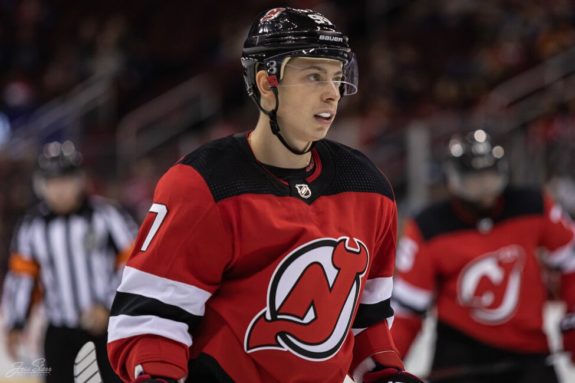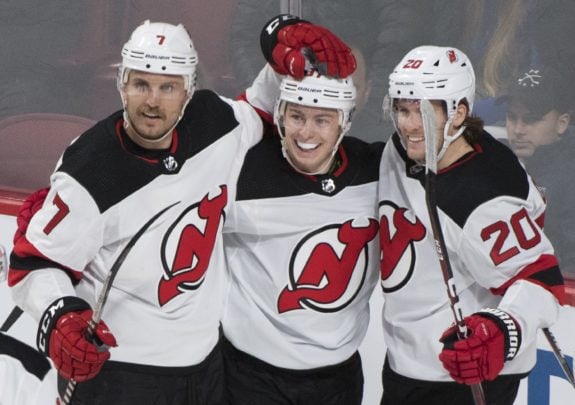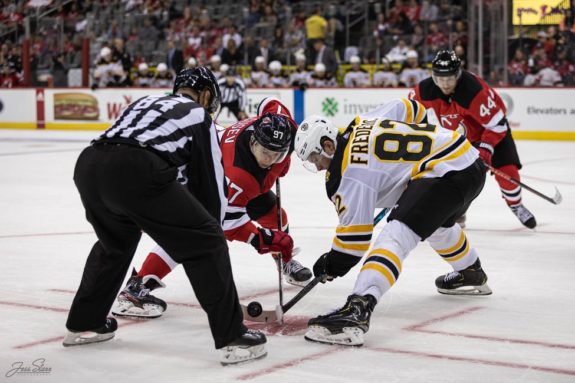The New Jersey Devils had one of the most active offseasons of any NHL team in 2019. They traded for P.K. Subban, drafted Jack Hughes with the first overall pick, and signed Wayne Simmonds in free agency. But no acquisition had more hype than that of Nikita Gusev, who the Devils acquired from the Golden Knights for a couple of draft picks.
Gusev was a star in the KHL, as he averaged more than a point-per-game from 2016 to 2019. He finished with 82 points in 62 games last season and was named the KHL’s most valuable player. He got off to a slow start with the Devils this season. But he’s found his game as of late and has turned into one of the team’s best offensive players if not the best.
Gusev Soaring to New Heights
There was always going to be a transitional phase from the KHL to the NHL for Gusev. But some folks, including myself, underestimated how much he would struggle right off the bat. He had four points in his first nine games, which isn’t the worst scoring pace, but it was his on-ice impact that was the most concerning.
Through his first nine games, Gusev had a Corsi share (CF%) of 34.44%, as well as an expected goals share (xGF%) of 30.70% at five-on-five. Not only were those the worst rates among any Devils’ player, but they were among the bottom five of any NHLer with at least 50 minutes played.

Why were the Devils struggling so much with Gusev on the ice? In simplest terms, they were bleeding shots and chances against. But a switch in linemates seems to have helped him significantly. He’s played most of his minutes with Travis Zajac and Blake Coleman since Nov. 1, two of the team’s best defensive forwards. And the change in Gusev’s on-ice percentages has been night and day.
| Stat | Percentage Since Nov. 1 | Ranking on Devils |
| CF% | 50.65% | 1st |
| xGF% | 54.08% | 1st |
| SF% | 50.48% | 1st |
| SCF% | 50.59% | 2nd |
| HDCF% | 54.35% | 3rd |
Gusev’s CF% is the best on the team since Nov. 1, as is his xGF% and shots on goal share (SF%). The Devils are also controlling a majority of the scoring (SCF%) and high-danger chances (HDCF%) when he’s on the ice. That’s a long way to come from where he was less than two months ago when all those numbers were close to 40% or below.
Related: Hall Trade Gives Bratt a Big Opportunity
Not only have Gusev’s on-ice numbers improved, but he’s also been one of the most efficient point producers in the league. His average of 2.92 points per 60 minutes ranks 11th in the NHL among forwards, putting him ahead of names such as Nikita Kucherov, Patrick Kane, and Jack Eichel. That doesn’t mean he’s better than those three, but it shows he can score among the NHL’s elite.
It’s Time to Reunite Hughes and Gusev
Gusev has come a long way in a short amount of time, but there’s still room for him to continue adding to his numbers. For starters, he only has six goals on the season and scored his first last night since Nov. 16 against the Montreal Canadiens. But his lack of goals isn’t necessarily for the lack of shots and chances, as he has 77 shots on goal in 34 games. If he keeps firing that many pucks on net, it’s hard to imagine his shooting percentage will remain at 7.7%.

While his shooting percentage should see some positive regression, other factors should help Gusev remain hot offensively. With Hall on the Arizona Coyotes, he’s now one of the Devils’ primary scoring threats, at both five-on-five and on the power play. So he should get a lot of minutes left empty by trading Hall away.
But taking on some of the minutes lost by Hall isn’t the only way for Gusev to remain hot. As great as he’s been alongside Zajac and Coleman, his production could rise with Hughes centering him instead. Hughes may only have 14 points in 34 games, but like Gusev, he’s creating an endless amount of shots and chances.
Related: 5 Devils Who Must Pick Up the Pace Without Hall
Since Nov. 1, Hughes has 53 shots on goal to go along with 24 high-danger chances. And since Hall’s trade a week and a half ago, he’s second on the team in shots on goal and high-danger chances. But the points haven’t been there because he doesn’t have linemates who can capitalize on the opportunities he’s creating.
The Devils tried pairing Gusev and Hughes together earlier in the season, and it was nothing short of a disaster. But they’re both very much different players than they were then. It makes sense to give them another shot together soon, especially if interim head coach Alain Nasreddine keeps Coleman, who’s a high volume shooter, alongside them. All three of those players will be around next season, and with 2019-20 being a lost cause, it makes sense to look ahead.
Gusev Can Have a Long-Term Future in New Jersey
The Devils took a gamble on trading for Gusev over the summer, but it seems to have paid off. There are reasons to believe he can be a long-term piece for them, as well. He doesn’t play a physical game that’ll lead to his play falling off a cliff. And unlike Hall, who relied heavily on his skating to drive offense, it isn’t what makes Gusev such an attacking threat.

Instead, it’s his hockey IQ and elite playmaking ability that makes him the player he is. That’s what makes him the perfect complementary piece to young, developing players like Nico Hischier and Hughes. And if he continues to improve as he has since Nov. 1, he should be playing alongside either of those two for a long time.
* * *
Advanced stats from Natural Stat Trick